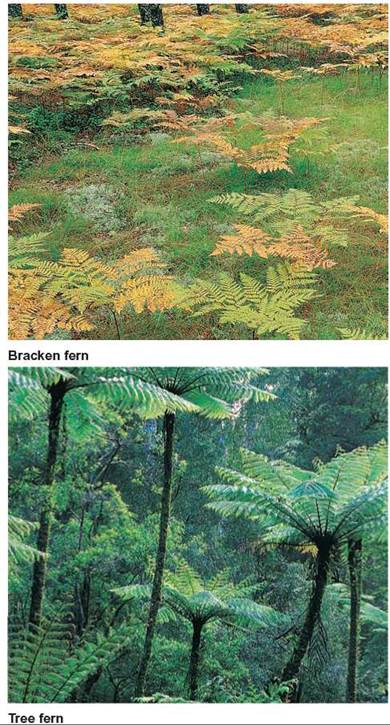CONCEPTS IN BIOLOGY
PART V. THE ORIGIN AND CLASSIFICATION OF LIFE
22. The Plants Kingdom
22.7. Seedless Vascular Plants
Seedless vascular plants include the ferns, horsetails, club mosses, and whisk ferns. They share several characteristics:
1. They have vascular tissue.
2. Most have roots, stems, and leaves.
3. The sporophyte generation is the most prominent part of the life cycle.
4. The sperm swims to the egg.
5. They do not have seeds.
With fully developed vascular tissues, these plants are not limited to wet areas, as are the mosses and other nonvascular plants. They can absorb water through their roots and distribute it to above-ground parts of the plant. However, because they have swimming sperm, they must have moist conditions at least for a part of their life cycle.
The Fern Life Cycle
Although there are differences in the details of the life cycles of seedless vascular plants, we will use the life cycle of ferns as a general model. The conspicuous part of the life cycle is the diploid sporophyte generation. The leaves of most ferns are complex, branched structures commonly called fronds. The sporophyte produces haploid spores by meiosis in special structures of the leaves. The spore-producing parts are typically on the underside of the leaves in structures called sori. However, some species have specialized structures whose sole function is the production of spores. The tiny spores are distributed by the wind or by water and when they fall to the ground, they give rise to a haploid, heart-shaped gametophyte, which has archegonia and antheridia. The sperm swims to the archegonium and fertilizes the egg. Typically, the sperm fertilizes an egg of a different gametophyte plant. Following fertilization of the egg, the diploid zygote derives nourishment from the gametophyte and begins to grow. Eventually, a new sporophyte grows from the gametophyte to begin the life cycle again. Figure 22.13 illustrates the life cycle of the fern.

FIGURE 22.13. The Life Cycle of a Fern
The sporophyte of a fern consists of an underground stem (rhizome) and roots and above-ground leaves. The leaves are known as fronds. On the back of some fern leaves are small dots called sori. Each sorus contains structures that produce spores by meiosis. These haploid spores develop into the heart-shaped gametophyte. The gametophyte has archegonia, which produce eggs, and antheridia, which produce sperm. The sperm swim to the egg. The fertilized egg (zygote) is diploid and grows into a new sporophyte plant.
Kinds of Seedless Vascular Plants
Ferns are the most common of the seedless vascular plants. There are about 12,000 species of ferns in the world. They range from the common bracken fern, found throughout the world, to tree ferns, seen today in some tropical areas (figure 22.14). Along with horsetails and club mosses, tree ferns were important members of the forests of the Carboniferous period, 360-286 million years ago.

FIGURE 22.14. Typical Ferns
There are many different kinds of ferns. The bracken fern is one of the most common. In some places, it is a weed that people try to eliminate from fields. The largest ferns are tree ferns.
Whisk ferns are odd plants that lack roots and leaves. They appear to be related to ferns. They are anchored in the soil by an underground stem, which has filaments growing from it that absorb water and soil nutrients. It has flattened structures similar to leaves, but they are not considered leaves because they lack vascular tissue. Whisk ferns are most common in warm, moist environments. There are about 15 species. The spores are produced at the ends of branches and produce a gametophyte in the soil.
Horsetails are low-growing plants with jointed stems. The leaves are tiny and encircle the stem at the joints. Much of the photosynthesis actually occurs in the green stem. There are about 15 species. They store silicon dioxide in their cell walls and, so, feel rough. They often are called scouring rushes because pioneers used them to clean pots and pans. The spores are produced in structures at the end of the stems. The spores give rise to gametophytes, which produce either eggs or sperm. Tree-sized members of this group are well known from the fossil record of the Carboniferous period.
Club mosses are usually evergreen, bright green, low- growing, branching plants. Because they are evergreen and have a slight resemblance to small pine trees, some kinds are called ground pines. Their leaves are small and have only a single bundle of vascular tissue. Over 1,000 species are alive today. Like the whisk ferns and horsetails, they produce spores in structures at the end of stems. The spores give rise to gametophytes. Like the horsetails, these plants were prominent trees like plants in ancient Carboniferous forests. Figure 22.15 shows examples of whisk ferns, horsetails, and club mosses.

FIGURE 22.15. Whisk Ferns, Horsetails, and Club Mosses
In addition to ferns, whisk ferns, horsetails, and club mosses are plants that have vascular tissue but do not have seeds. Whisk ferns are primarily tropical. They are odd plants that lack leaves and roots. Part of the stem is underground; the above-ground part is green and carries on photosynthesis. Horsetails and club mosses are common throughout North America.
22.7. CONCEPT REVIEW
12. List three ways that vascular seedless plants differ from nonvascular plants.
13. What kinds of vascular plants do not produce seeds?
14. Describe the life cycle of a fern.